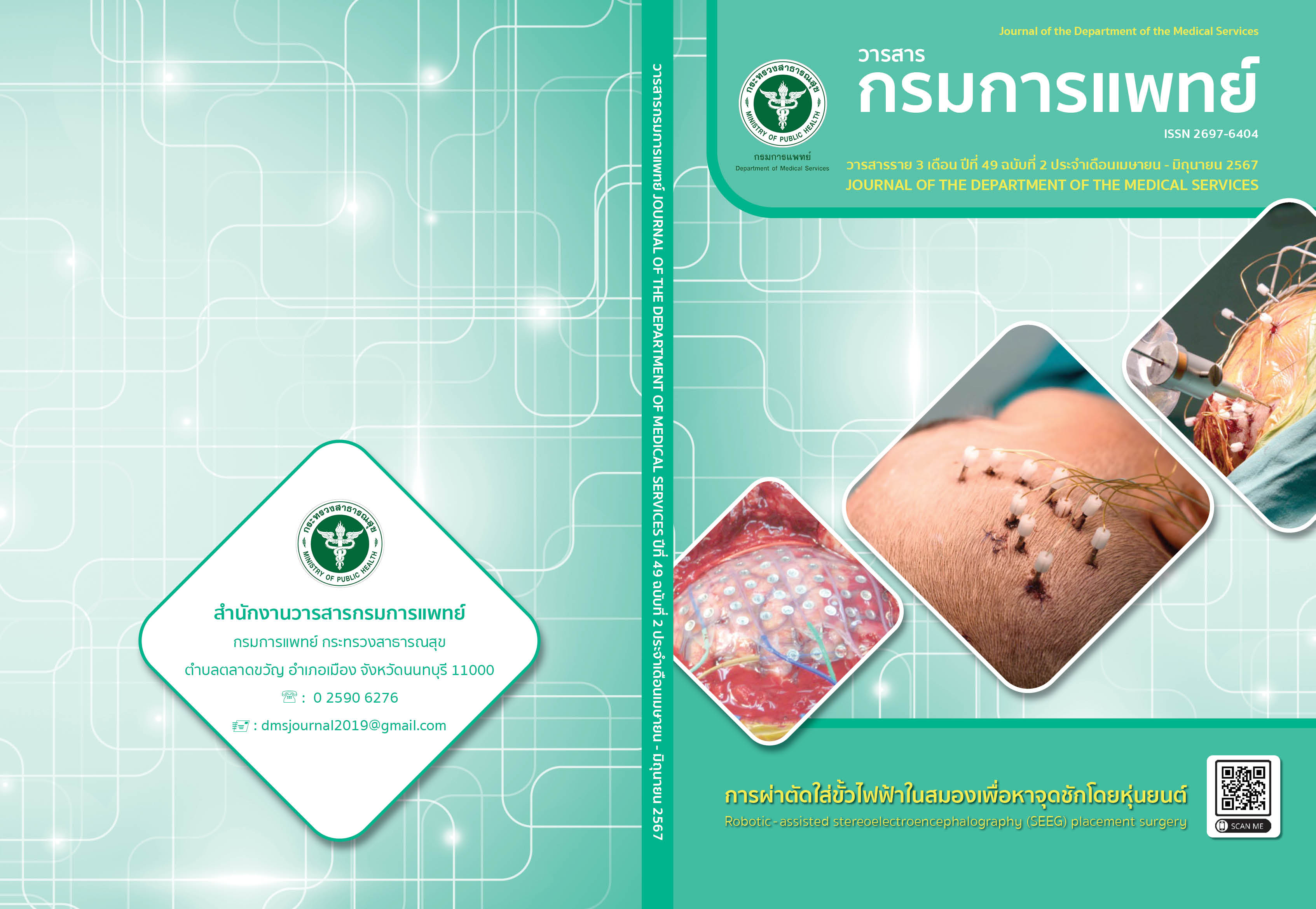รายงานผู้ป่วยโรคมะเร็งต่อมน้ำเหลืองชนิด Mycosis Fungoides ที่มีเซลล์ขนาดใหญ่ขึ้น และมีผลตรวจด้วยวิธีอิมมูโนฮีสโตเคมีพบ CD30 เป็นบวก
คำสำคัญ:
มะเร็งต่อมน้ำเหลืองชนิด mycosis fungoides, CD30-positive Large Cell Transformation, มะเร็งต่อมน้ำหลืองบทคัดย่อ
Mycosis fungoides เป็นมะเร็งต่อมน้ำเหลืองชนิด T-cell ที่พบได้บ่อยที่สุด โดยคิดเป็นร้อยละ 50 ของมะเร็งต่อมน้ำเหลืองชนิดปฐมภูมิทั้งหมด มักเกิดกับผู้สูงอายุที่มีอายุเฉลี่ย 55 - 60 ปี และพบมากในเพศชาย แม้ว่าจะไม่ทราบสาเหตุของโรค mycosis fungoides ที่แน่ชัด แต่พบว่าปัจจัยที่มีส่วนสนับสนุนในการเกิดโรค เช่น พันธุกรรม สิ่งแวดล้อม และระบบภูมิคุ้มกัน เป็นต้น โรคมะเร็งต่อมน้ำ เหลืองชนิด mycosis fungoides ที่มีเซลล์ขนาดใหญ่ขึ้น พบได้น้อยและมีการพยากรณ์โรคที่ไม่ดี รายงานผู้ป่วยรายนี้ เป็นหญิงอายุ 48 ปี มีเนื้องอกที่เป็นแผลบริเวณคอ ลำตัว ขาหนีบ และแขนขา เป็นระยะเวลา 4 เดือน ผู้ป่วยได้รับการตัดชิ้นเนื้อและส่งตรวจด้วยวิธีทางอิมมูโนฮีสโตเคมี ผู้ป่วยได้รับการวินิจฉัยว่าเป็นมะเร็งต่อมน้ำเหลืองชนิด mycosis fungoides ที่มีเซลล์ขนาดใหญ่ขึ้น และมีผลตรวจด้วยวิธีอิมมูโนฮีโตเคมี พบ CD30 เป็นบวก
เอกสารอ้างอิง
Pulitzer M, Myskowski PL, Horwitz SM, Querfeld C, Connolly B, Li J, et al. Mycosis fungoides with large cell transformation: clinicopathological features and prognostic factors. Pathology 2014;46(7):610-6.
Kadin ME, Hughey LC, Wood GS. Large - cell transformation of mycosis fungoides - differential diagnosis with implications for clinical management: a consensus statement of the US Cutaneous Lymphoma Consortium. J Am Acad Dermatol 2014;70(2):374-6.
Willemze R. Cutaneous T - cell lymphoma. In: L BJ, editor. Bolognia Dermatology. 4th ed. Edinburg: Elsevier; 2018. p.2139-42.
Bagot M, Stadler R. Cutaneous lymphoma. In: Kang S, Amagai M, Bruckner AL, editors. Fitzpatrick’s dermatology in general medicine. 9th ed. New York: Mcgraw - Hill; 2012. p. 2084-7.
Kubo N, Itoh M, Watanabe Y, Nobeyama Y, Asahina A. Regression of CD30 - positive large cell transformation arising on patch lesion of early mycosis fungoides. Clin Case Rep 2020;8(12):2418-22.
Rasso A, Sara E, Kaoutar A, Hanane B, Zahra MF. Mycosis fungoides with CD30 large cell transformation accompanied by hidden adenocarcinoma of the colon: a case report. PAMJ - Clin Med 2020;2:1-8.
Herrmann JL, Sami N. Large - cell transformation of mycosis fungoides occurring at the site of previously treated cutaneous B - cell lymphoma. Clin Lymphoma Myeloma Leuk 2014;14(1):e43-6.
Horwitz SM, Olsen EA, Duvic M, Porcu P, Kim YH. Review of the treatment of mycosis fungoides and sézary syndrome: a stage - based approach. J Natl Compr Canc Netw 2008;6(4):436-42.
Asai H, Takeuchi K, Ikeda Y, Ochi T, Tanimoto K, Yamanouchi J, et al. Successful treatment of large transformed mycosis fungoides with gemcitabine monotherapy. Ann Oncol 2018;29(Supplr 7):77.
O’Donnell M, Zaya R, Correia E, Krishnasamy S, Sahu J, Shi W, et al. Disease characteristics, prognosis, and response to therapy in patients with large - cell transformed mycosis fungoides: A single - center retrospective study. J Am Acad Dermatol 2022;86(6):1285-92.
Chowdhary M, Chhabra AM, Kharod S, Marwaha G. Total Skin Electron Beam Therapy in the Treatment of Mycosis Fungoides: A Review of Conventional and Low - Dose Regimens. Clin Lymphoma Myeloma Leuk 2016;16(12):662-71.
Jothishankar B, Almazan T, Kim Y, Liauw S, Smith S, Kline J, et al. Romidepsin and total skin electron beam therapy in advanced stage mycosis fungoides and Sézary syndrome. Br J Haematol. 2019;186(2):377-9.
Seidl - Philipp M, Nguyen VA. New systemic treatment options in mycosis fungoides and Sézary syndrome. Memo 2020;13:280-4.
ดาวน์โหลด
เผยแพร่แล้ว
รูปแบบการอ้างอิง
ฉบับ
ประเภทบทความ
สัญญาอนุญาต
ลิขสิทธิ์ (c) 2024 กรมการแพทย์ กระทรวงสาธารณสุข

อนุญาตภายใต้เงื่อนไข Creative Commons Attribution-NonCommercial-NoDerivatives 4.0 International License.
บทความที่ได้รับการตีพิมพ์เป็นลิขสิทธิ์ของกรมการแพทย์ กระทรวงสาธารณสุข
ข้อความและข้อคิดเห็นต่างๆ เป็นของผู้เขียนบทความ ไม่ใช่ความเห็นของกองบรรณาธิการหรือของวารสารกรมการแพทย์



